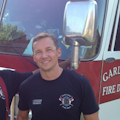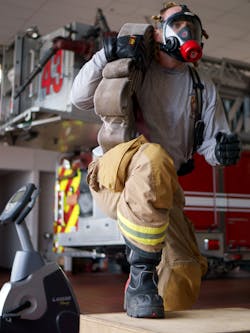Health & Wellness: What Does It Mean to Be Fit for the Fire?
It is a well-known fact that the number one killer of firefighters is stress or overexertion causing sudden cardiac death. Clearly something is missing in our preparation to be physically fit to fight fire.
The Indiana University research emphatically states, “The discrepancy between the physical preparedness of firefighters and the high demand of firefighting stands at the center of fire service line-of-duty deaths.” Leading that research is Dr. Jim Brown, director of Firefighter Health & Safety Research, who explains, “Development of an effective physical training program begins with the identification of demand levels a job or event presents.”1
There are a variety of factors unique to firefighting that call for specific training and adaptations. Some of the widely studied elements are the weight of our gear and the increase in body temperature. Some of the less discussed, but equally important, factors are the effect that SCBA has on our ability to work and the psychological impacts of our equipment. We must consistently train on these specific components of our profession to drive adaptation.
But what about those of us who not only want to survive on the fireground, but also set the example and excel as aggressive interior firefighters? If you are a tactical athlete and your sport is fighting fire, your training must match that. We can all guess what would happen if we took a marathon runner and put him or her in bunker gear, strapped them in an SCBA, put a charged 1¾-inch line in their hands and pushed them into a burning house. As great of a runner as they might be, they will be overwhelmed by the task. How about the other end of the spectrum? A powerlifter who bench-presses 500 pounds will find themselves in the same boat as the marathon runner because neither of these athletes have trained for the specific stresses and adaptations that fighting fire requires. A fire athlete must train to be fit for the fire.
Measuring fitness
Every sport has measurements to tell you how well an athlete has performed, or is expected to perform. In firefighting, the most vital measurement may be VO2 max.
VO2 max is the maximal oxygen uptake or the maximum volume of oxygen that can be utilized during maximal or exhaustive exercise; it is considered the best indicator of cardiorespiratory endurance. And it has been shown to be one the best predictors for success for passing the CPAT.2 VO2 max has been consistently identified as an important factor in the association of firefighting demands and physiological requirements.1
VO2 max is measured in mL/kg/min, with the minimum level recommended for firefighters, as determined by the IAFF, set at 42 mL/kg/min.3 It has been shown that individuals with VO2 max values below 33.5 mL/kg/min are unable to complete a standard fire suppression protocol.1 To directly compare this to other sports, search and rescue is as intense as, or even more intense than, pro football, requiring an energy expenditure of up to 16 METS (metabolic equivalent), which equates to a VO2 max of 56 mL/kg/min.4
Operating in your SCBA might be having a more dramatic effect on your ability to work than you realize. Research has shown that during heavy work, the SCBA greatly reduces maximal exercise performance. Clinical data shows that a full SCBA system lowers VO2 max by 14.9 percent, with the regulator alone lowering it by 13.1 percent.5 To show how significant this 14.9 percent is, let us look at some VO2 max values common to firefighters.
A sample of paid firefighters was found to have a mean VO2 max of 40.57 mL/kg/min.1 When that is reduced 14.9 percent by the SCBA, it gets lowered to 34.52 mL/kg/min—or just 1 mL/kg/min over the minimum required for completing the standard fire suppression protocol discussed earlier. Further, 75 percent of volunteer firefighters tested were found to have a VO2 max between 20 and 39 mL/kg/min.1 That means when their VO2 max values are adjusted for the SCBA, 75 percent or more of volunteer firefighters do not meet the minimum level to perform a fire suppression protocol.
Physiological reinforces psychological
We have all seen new recruits who are not quite comfortable in their gear; some get claustrophobic the second they don their SCBA. Hopefully with practice and repetition that goes away so the rookie does not lose their dream job, and the department does not lose its investment. But how many of us have also seen the 15- or 20-year firefighter who, after a career of fighting fire, starts pulling their facepiece off and cannot work in an SCBA? Why does that happen?
With the frequency of fires today, maybe that vet is a year or two older since the last time they really had to go all out in a fire. They are likely a step or two slower. Now the physiological aspects are hitting them harder than ever. In their mind, the job is tougher—it is “for the young guys (or girls).” Once those physiological and psychological effects start reinforcing each other, it is only a matter of time before they become insurmountable and the mask comes off.
While implementing a mandatory physical-ability test for Clearview Fire and Emergency Services in Ontario, Canada, Deputy Chief Roree Payment noted, “Why they failed had nothing to do with the physical element, it actually had everything to do with their confidence in an SCBA.”6 A firefighter simply must be able to confidently and calmly work under a variety of added psychological stressors, and that comes through repetition and familiarity.
Practice how you play
Fighting fire is made up of a combination of aerobic and anaerobic demands, combined with extreme heat, added weight, unique cardiorespiratory effects, and psychologically challenging environments. How do we become functionally fit to fight fire, or practice how we play? Most departments simply do not have a high enough volume of structure fires to rely on the job to keep them in shape.
A base layer of strength and cardio conditioning comes first. If you are not there yet, start slowly, master the basics, and begin today. Fitness is your duty. Especially when your life depends on it, even more so when the man or woman going in the fire with you depends on it as well.
Beyond that basic level of fitness, the goals are to increase VO2 max and mimic the stresses and movements of the fireground as closely as possible. We push, we pull, we crawl, we lift and we drag. These are all movements that are done in burning structures—they just have to be translated into an organized, progressive program. Sandbags and kettlebells are extremely functional tools. Hose drags and dummy drags are direct simulations of things that we do. Anything going up stairs carrying weight will be effective. Tire flips and battle hoses make great stations to rotate a crew through and build camaraderie at the same time. There are several practical programs created by firefighters for firefighters; it is always a good idea to rely on experts to help design your routine. Consistency is the key factor for whatever plan you choose, but you have to keep making progress and moving forward.
An important consideration is how closely to simulate fireground conditions. Should we train in bunker gear? Should we train in SCBAs? Some skills need to be completed in full gear from time to time. It is necessary. We have to work at maximum output for prolonged periods in very specific equipment; there is no way around that. The range of motion and body heat-trapping elements of our PPE can be paralyzing if not prepared for. The SCBA has known physiological and psychological effects that build on each other. As such, there is no option but to train frequently enough in full equipment to be ready to do the job in that gear.
But with all the known cancer risks, is it worth doing regular conditioning in dirty turnouts? What about taking equipment out of service to train, and not having it ready to respond? One of the benefits of functional fitness is that it mimics what we do closely enough that it readily translates. And there are a variety of functional simulation tools designed to take the place of that dirty gear. There are sandbags to replicate weight and training regulators to simulate the SCBA breathing sensation. Use old hoses for dragging or get a sledgehammer off the truck. Use what you can, when you can, and weigh the risk vs. reward.
In sum
As the timeless advice from Greek soldier Archilochus states, “We don't rise to the level of our expectations, we fall to the level of our training.” You simply cannot expect to summon a level of fitness that you have never attained when you and your crew need it the most.
References
1. Brown J, Stickford J. Physiological Stress Associated with Structural Firefighting Observed in Professional Firefighters. Firefighter Health & Safety Research & Department of Kinesiology of Indiana University, Bloomington, IN, 2009.
2. Leatherman K. What is VO2 max and why is it important to your total fitness? Carolina Fire Rescue EMS Journal. 2015. www.carolinafirejournal.com.
3. Moore K. Toward the Development of Screening Tests for Heart Attacks and Back Injuries in Firefighters: A Study to Investigate Back-Specific Fitness, Perceived Fitness and Aerobic Capacity in a Firefighter Population. Oregon State University, Corvallis, OR, 2012.
4. FSTAR Research Infographic, “Know Your METS.” www.fstaresearch.org/resource/?FstarId=11503
5. Eves ND, Petersen SR, Jones RL. The influence of the self-contained breathing apparatus (SCBA) on ventilator function and maximal exercise. Canadian Journal of Applied Physiology. 2005; 30:507-19.
6. Church, M. Mandating Fitness, How firefighter engagement and strong leadership ensure member buy in. Firefighting in Canada. 2016; 4:10-14.
About the Author

Justin C. Dickstein
Justin C. Dickstein is a captain in the Garland, TX, Fire Department. He has been a frontline officer in responses to both an ISIS-inspired terrorist attack and an EF4 tornado. He has a bachelor’s degree and a master’s degree from The University of Texas at Austin. He is a co-author of The Station-Ready Rookie (PennWell, 2015). He is the creator of the BlastMask training regulator (BlastMask.com).
